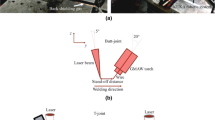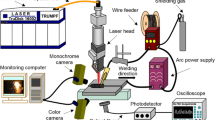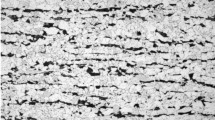Abstract
A hybrid laser-tungsten inert gas (LasTIG) welding system was applied for 3-mm-thick S460MC and S700MC high-strength low-alloy steel sheet butt welding with the aim to reduce the cooling rate compared with laser welding. The effect of the electric current was evaluated. Increasing arc current led to the increase of fused metal and heat-affected-zone (HAZ) dimensions. Fused metal grains were larger whereas the microhardness increase toward the base metal was lower at higher currents in this region. Microhardness peaks corresponding to the coarse-grained HAZ were reduced at higher currents for S460MC but were almost not affected in S700MC. The tensile strength of both the laser weld and LasTIG welds was comparable to the base metal for both alloys.















Similar content being viewed by others
References
[1] X. Cao, P. Wanhara, J. Huang, C. Munro, A. Nolting: Mater. Des., 2011, vol. 32, pp. 3399-3413.
[2] C.J. Bayley, A. Mantei: Can. Met. Quart., 2009, vol. 48, pp. 311-316.
[3] K. Sampath: J. Mater. Eng. Perform., 2006, vol. 15, pp. 32-40.
[4] J. Brozda, M. Zeman, M. Lomozik: Weld. Int., 2000, vol. 14, pp. 593-605.
EN 10025-4: Hot rolled products of structural steels-part 4: technical delivery conditions for thermomechanical rolled weldable fine grain structural steels, 2004.
EN 10149-2: Hot rolled flat products made of high yield strength steels for cold forming-part 2: technical delivery conditions for thermomechanically rolled, 2013.
[7] W. Xu, D. Westerbaan, S. S. Nayak, D.L. Chen, F. Goodwin, Y. Zhou: Mater. Des., 2013, vol. 43, pp. 373-83.
J. Górka and S. Stanoba: Proc. SPIE 10159, 2016, pp. 101590K.
[9] W.M. Steen: Laser Material Processing, 2nd ed., Springer, London, 1998.
[10] X. Yue, J.C. Lippold, B.T. Alexandrov, S.S. Babu: Weld. J., 2012, vol. 91, pp. 67S-75S.
J. Zhou and H.L. Tsai: Hybrid Laser-Arc Welding, Welding Processes, R. Kovacevic, ed., InTech, 2012, http://cdn.intechopen.com/pdfs/40994/InTech-Hrbrid_laser_arc_welding.pdf. Accessed 17 January 2018.
[12] F. Möller, H. Kügler, S. Kötschau, A. Geier, S. F. Goecke: Phys. Procedia, 2014, vol. 56, pp. 620-629.
[13] G. Song, L.M. Liu, M.S. Chi, J.F. Wang: Mater. Sci. Forum, 2005, vol. 488–489, pp. 371–375.
[14] C. Kim, W. Choi, J. Kim, S. Rhee: Mater. Trans., 2008, vol. 49, pp.179-186.
[15] A.D. Samigullin, D.A. Bashmakov, I.Kh. Israphilov, G.A. Turichin: J. Phys.: Conf. Ser., 2017, vol. 789, pp. 012048.
[16] F. Chaussé, P. Paillard, E. Bertrand, G. Rückert: J. Laser Appl., 2016, vol. 28, pp. 022416.
T. Kim, Y. Suga, T. Koike (2003) JSME Int. J., Ser. A, 46:202-207.
Y. Murata, K. Yokoyama, A.S. Baskoro, and Y. Suga: Proc. of the Materials and Processing Conference, 2009.
M. Sohail, M. Karhu, S.J. Na, S.W. Han, and V. Kujanpaa: J. Laser Appl., 2017, vol. 29, pp. 042009:1–14.
[20] G. Casalino, S.L. Campanelli, U. Dal Maso, A.D. Ludovico: Procedia CIRP, 2013, vol. 12, pp. 151-156.
Voestapline Steel & Service Center GmbH, Inspection Certificate: S460MC, 6 April 2017.
Voestapline Steel & Service Center GmbH, Inspection Certificate: S700MC, 16 March 2017.
[23] N. Yurioka: Welding in the World, 2004, vol. 48, pp. 21-27.
[24] S.W. Banovic, T. Foecke, W.E. Luecke, J.D. McColskey, C.N. McCowan, T.A. Siewert, F.W. Gayle: JOM, 2007, vol. 59, pp. 22-30.
M. Singh, T. Ohji, and R. Asthana: Green and Sustainable Manufacturing of Advanced Material, Elsevier Science Publishing Co Inc., 2015. ISBN: 978-0-12-411497-5.
K. Hulka: The role of niobium in low carbon bainitic HSLA steels, Niobium Products Company GmbH, Dűsseldorf, Germany. https://www.phase-trans.msm.cam.ac.uk/2005/LINK/10.pdf. Accessed 23 January 2018.
[27] J. Górka: Materiali in Tehnologie, 2016, vol. 50, pp. 617-621.
Voestapline Steel & Service Center GmbH, High-strength and ultra-high strength thermo-mechanically rolled fine-grained steels, 2014. http://www.voestalpine.com/alform/en/Media-Center/Downloads. Accessed 23 January 2018.
[29] Z. Liu, M. Kutsuna: Weld. Soc. Proc., 2006, vol. 24, pp. 344-349.
[30] K. Poorhaydari, B.M. Patchett: D.G. Ivey: Microsc. Microanal., 2002, vol. 8, pp. 1252-1253.
[31] J. Bian, H. Mohrbacher, J.S. Zhang, Y.T. Zhao, H.Z. Lu, H. Dong: Adv. Manuf., 2015, vol. 3, pp. 27–36.
J.N. DuPont: Fundamentals of Weld Solidification, ASM Handbook, Volume 6A, Welding Fundamentals and Processes, ASM International, 2011. https://www.lehigh.edu/matsci/faculty/dupont/docs/Fundamentals_of_Weld_Solidification.pdf. Accessed 11 December 2017.
[33] S. Kou: Welding Metallurgy, 2nd ed. Hoboken, NJ: John Wiley & Sons, 2003.
[34] Y.Q. Zhang, H.Q. Zhang, J.F. Li, W.M. Liu: J. Iron Steel Res. Inter., 2009, vol. 16, pp. 73-80.
M. Maalekian: The Effects of Alloying Elements on Steels (I), Technische Universität Graz, 2007. https://online.tugraz.at/tug_online/voe_main2.getvolltext?pCurrPk=32837. Accessed 4 January 2018.
[36] Y. Tian, H.T. Wang, Y. Li, Z.D. Wang, G.D. Wang: Mater. Res., 2017, vol. 20, pp. 853-859.
[37] S.R. Nathan, V. Balasubramanian, S. Malarvizhi, A.G. Rao: Defence Technol., 2015, vol. 11, pp. 308-317.
[38] C. Capdevila, F.G. Caballero, C. García de Andrés: J. Mater. Sci. Technol., 2003, vol. 19, pp. 581-586.
[39] C. Munro, A. Nolting, X. Cao, P. Wanjara: Mater. Sci. Forum, 2012, vol. 706-709, pp. 2992-2997.
Acknowledgments
This research was supported by the Technology Agency of the Czech Republic (Project GAMA TG03010046) and the Ministry of Education, Youth and Sports of the Czech Republic (Project LO1212). The research infrastructure was funded by the Ministry of Education, Youth and Sports of the Czech Republic and the European Commission (Project CZ.1.05/2.1.00/01.0017) and by the Czech Academy of Sciences (Project RVO:68081731). The authors would like to thank Ing. Kamil Podaný, PhD, for the tensile test execution.
Author information
Authors and Affiliations
Corresponding author
Additional information
Manuscript submitted April 17, 2018.
Rights and permissions
About this article
Cite this article
Šebestová, H., Horník, P., Mrňa, L. et al. The Effect of Arc Current on Microstructure and Mechanical Properties of Hybrid LasTIG Welds of High-Strength Low-Alloy Steels. Metall Mater Trans B 49, 3559–3569 (2018). https://doi.org/10.1007/s11663-018-1385-6
Received:
Published:
Issue Date:
DOI: https://doi.org/10.1007/s11663-018-1385-6




